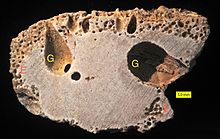Drilled gaping clams
| Drilled gaping clams | ||||||||||||
|---|---|---|---|---|---|---|---|---|---|---|---|---|

Gastrochaena sp. |
||||||||||||
| Systematics | ||||||||||||
|
||||||||||||
| Scientific name | ||||||||||||
| Gastrochaenidae | ||||||||||||
| Gray , 1840 |
The Bohrklaffmuscheln (Gastrochaenidae) are a shell - Family from the order of Imparidentia . The oldest members of the family are known from the Bathonium ( Middle Jurassic ).
features
The housings, which have the same flaps but are very unequal- sided, are usually small. The vertebrae sit near the anterior end, the outline is elongated-ovoid (modioliform). The housings gape at the front end and usually also over the entire ventral edge. The ligament is located externally behind the vertebrae on a ridge. The lock has only a few teeth, or is adont, hh without teeth.
The surface line is deeply indented. There is only one sphincter impression, the anterior sphincter is almost completely reduced. The siphons are of different lengths. The surface is usually little sculpted, often only concentric growth strips are formed. The thin shell is aragonitic . The outer layer has a microstructure of cross lamellas, the inner layer is complex cross-lamellar. Both layers can, however, also be homogeneous. The tube is divided into a rear chamber, in which the housing is located, and a front siphon chamber.
Geographical distribution, habitat and way of life
The family is spread around the world. The main focus of diversity, however, is the warmer seas. The oldest representatives come from the Middle Jura.
The animals drill mechanically and chemically in rock, coral sticks or mollusc shells. They line the borehole with a chalky tube, which they extend a little over the edge of the borehole as protection for the long siphons.
Taxonomy
The taxon was established in 1840 by John Edward Gray . According to MolluscaBase and Carter et al. (2008) the following genera are placed in the family Gastrochaenidae.
- Clam family (Gastrochaenidae)
- † Carterochaena Fürsich, Palmer, Goodyear, 1994
- Cucurbitula Gould, 1861
- Dufoichaena Jousseaume in Lamy, 1925
- Eufistulana Eames, 1951
- Gastrochaena Spengler, 1783
- † Gastrochaenopsis Chavan, 1952
- † Kummelia Stephenson, 1937
- Lamychaena Freneix, 1979
- † Llosaria Quintana, 2015
-
Rocellaria Blainville, 1828
- Rocellaria dubia (Pennant, 1777)
- Spengleria Tryon, 1861
- Spenglerichaena Carter, 2011
Synonyms are Chaenidae Gray, 1858 and Rocellariidae Ridewood, 1903.
supporting documents
literature
- Michael Amler, Rudolf Fischer & Nicole Rogalla: Mussels . Haeckel-Bücherei, Volume 5. Enke Verlag, Stuttgart 2000 ISBN 3-13-118391-8 (p. 96 Gastrochaenoidea).
- John G. Carter, T. McDowell, N. Namboodiri: The identity of Gastrochaena cuneiformis Spengler, 1783, and the evolution of Gastrochaena, Rocellaria, and Lamychaena (Mollusca, Bivalvia, Gastrochaenoidea). Journal of Paleontology 82 (1): 102-117 2008 [: http://www.jstor.org/stable/20144173 JSTOR]
- Rudolf Kilias: Lexicon marine mussels and snails. 2nd edition, 340 p., Verlag Eugen Ulmer, Stuttgart 1997 ISBN 3-8001-7332-8 (p. 127)
- Raymond Cecil Moore (Ed.): Treatise on invertebrate paleontology. Mollusca, 6, Part N, Bivalvia 2. XXXVIII S., S.N491-951, New York, 1969 (S.N699).
- Brian Morton, Melita Peharda, Mirela Petrić: Functional morphology of Rocellaria dubia (Bivalvia: Gastrochaenidae) with new interpretations of crypt formation and adventitious tube construction, and a discussion of evolution within the family. Biological Journal of the Linnean Society, 104: 786–804, 2011. PDF (ResearchGate)
- Fritz Nordsieck : The European sea shells (Bivalvia). From the Arctic Ocean to Cape Verde, the Mediterranean Sea and the Black Sea. 256 p., Gustav Fischer Verlag, Stuttgart 1969 (p. 151)
- Guido Poppe and Yoshihiro Goto: European Seashells Volume 2 (Scaphopoda, Bivalvia, Cephalopoda) . 221 pp., Verlag Christa Hemmen, Wiesbaden 1993 (2000 unc. Reprint), ISBN 3925919104 (p. 129)
Individual evidence
- ↑ Yasuo Kondo, Shin-ichi Sano: Origination of extant heteroconch families: Ecological and environmental patterns in post-Paleozoic bivalve diversification. Palaeontological Research, 13: 39-44, Tokyo 2009 doi : 10.2517 / 1342-8144-13.1.039
- ↑ John Edward Gray: Shells of molluscous animals. Synopsis of the contents of the British Museum, 42: 105-152, Woodfall & Son, London 1840 Online at Google Books (p. 134)
- ↑ a b MolluscaBase: Gastrochaenidae Gray, 1840
- ^ A b Franz Theodor Fürsich, Timothy J. Palmer, Kay L. Goodyear: Growth and disintegration of bivalve-dominated patch reefs in the Upper Jurassic of southern England. Palaeontology, 37: 131-171, 1994
- ^ Lloyd W. Stephenson: The stratigraphic significance of Kummelia, a new Eocene bivalve genus from New Jersey. Journal of the Washington Academy of Sciences, 27: 58-64, 1937 Online at www.biodiversitylibrary.org
